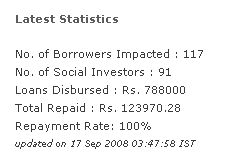Zopa.it goes live: 16th January 2008*
Average gross return on money lent-out through Zopa.it: 7.66%
Average annual cost on loans (APR) borrowed through Zopa.it: 9.45%
Registered members of Zopa.it: 23,242
Total loan volume since launch: €2,787,090
Number of loans: 535
Loan volume currently under evaluation process: €336,690
Average loan amount: €5,210
Average loan duration: 31 months
Amount rate late:€6,622.24 (percentage amount late: 1.88%) = 6 loans (this fig. as of end of Aug.)
Demographic characteristics of the Zopa users:
Female: Â Â Â 15%
Male:Â Â Â Â Â Â Â 85%
18 – 24 years old:     5%
25 – 34 years old:    32%
35 – 44 years old:    35%
45 – 54 years old:    19%
55 – 64 years old:     7%
65+Â years old:Â Â Â Â 2%
First 3 regions by number of registered members: Lombardia (18%), Lazio(13%), Campania(9%)
The most popular uses for the money borrowed from lenders through Zopa.it:
Home improvement /furniture: 28%
Debt consolidation / pay off loan from relatives: 26%
Car / motor bike: 12%
Unexpected expenses / Repairs: 9%
Family events (wedding, school fees, medical expenses…): 7%
All data as of Sep. 3rd, 2008 (Source: Zopa Italy management, Zopa blog)
*public launch; there was a 2 month period before, that was open by invitation only since Nov. 14th

 Indian non-profit
Indian non-profit  Lenders can select a borrower by browsing profiles. RangDe’s field partners receive and disburse the loan to the borrower, which pays a fixed interest rate of 8.5%, of which the field partner receives 5% and the lender receives 3.5%. Lenders need an Indian bank account to participate.
Lenders can select a borrower by browsing profiles. RangDe’s field partners receive and disburse the loan to the borrower, which pays a fixed interest rate of 8.5%, of which the field partner receives 5% and the lender receives 3.5%. Lenders need an Indian bank account to participate.